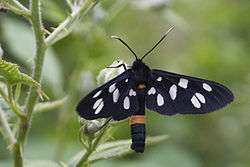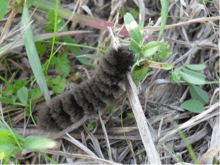Nine-spotted moth
| Nine-spotted moth | |
|---|---|
 | |
| Adult male of Amata phegea | |
 | |
| Caterpillar of Amata phegea | |
| Scientific classification | |
| Kingdom: | Animalia |
| Phylum: | Arthropoda |
| Class: | Insecta |
| Order: | Lepidoptera |
| Superfamily: | Noctuoidea |
| Family: | Erebidae |
| Subtribe: | Ctenuchina |
| Genus: | Amata |
| Species: | A. phegea |
| Binomial name | |
| Amata phegea (Linnaeus, 1758) | |
| Synonyms | |
| |
The nine-spotted moth (Amata phegea) is a moth in the family Erebidae ("tiger moths").
It reaches a wing span of 35–40 millimetres (1.4–1.6 in). Its wings are blueish black with white spots. A further feature is the prominent yellow ring at the abdomen. The black antennae have white tips.
Similar-looking moths include Amata ragazzii (Turati, 1917) and Zygaena ephialtes (Linnaeus, 1758). Z. ephialtes is in the family Zygaenidae and is unpalatable to birds; the nine-spotted moth imitates its appearance (mimicry).
The nine-spotted moth is chiefly found in southern Europe but also seen up to northern Germany, and in the East to Anatolia and the Caucasus, and there are some populations in the South-Eastern Dutch nature reserves "Leudal" and "De Meinweg" The species prefers drier areas, open ranges with shrubs and trees as well as open forests and slopes.
External links
 Media related to Amata phegea at Wikimedia Commons
Media related to Amata phegea at Wikimedia Commons Data related to Amata phegea at Wikispecies
Data related to Amata phegea at Wikispecies- Nine-spotted moth at UK Moths